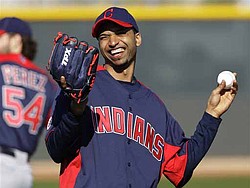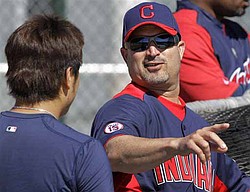The Tribe's Top 10 questions
AP
Cleveland Indians relief pitcher Rafael Perez laughs during warmups at baseball spring training practice Thursday, Feb. 17, 2011, in Goodyear, Ariz.
AP
Cleveland Indians manager Manny Acta, right, talks with outfielder Shin-Soo Choo during baseball spring training practice Thursday, Feb. 17, 2011, in Goodyear, Ariz.
By Paul Hoynes
The Cleveland Plain Dealer
CLEVELAND
The Indians and Yankees don’t have much in common besides playing in the American League. Still, there are ties that bind.
They’re not perfect. The Indians lost 93 games last season and if the Yankees had it all figured out, Bartolo Colon wouldn’t be going to camp with a chance to win a job in their starting rotation.
What we have here are two teams, just like their 28 partners, who have questions about what lies ahead. Spring training begins this week. The 162-game regular season follows.
The Yankees’ payroll, pushing $200 million, will provide the answers to most questions. The Indians’ payroll of between $45 million and $50 million is hardly enough to solve the concerns facing manager Manny Acta and first-year GM Chris Antonetti.
Just in case they’ve forgotten, here are 10 of the biggest questions facing the Tribe in 2011:
How much can a healthy Grady Sizemore improve an offense that finished 26th in the big leagues with 646 runs?
Best case scenario: Sizemore’s left knee is sound and he returns to his old form when he averaged 116 runs and played 160 games per season from 2005-08.
Worst case scenario: Sizemore’s knee isn’t fully healed and the Indians’ second-highest paid player at $7.5 million is idle for much of the year.
What will probably happen: As a precaution Sizemore doesn’t join the Indians until mid-April, but regains his skills. The Indians trade him to a contender before the July 31 or Aug. 31 trading deadlines rather than exercising his 2012 club option for $9 million.
Who is going to play second and third base?
Best case scenario: Orlando Cabrera wins the second base job midway through spring training. Jason Donald emerges from the pack to take third in a close competition with Jayson Nix, Luis Valbuena and Jack Hannahan.
It works out well because the Indians can let Lonnie Chisenhall, Jason Kipnis, Cord Phelps and Jared Goedert get more experience in the minors. In September, Chisenhall, Kipnis, Phelps and Goedert get a taste of the big leagues in preparation for 2012.
Worst case scenario: Cabrera turns into Shawon Dunston and can’t make the transition from shortstop to second base. Dunston, a great shortstop with the Cubs, couldn’t play second for the Tribe in the spring of 1998 and became a utility player.
Donald has trouble at third once the regular season starts. Nix struggles as well and the Indians are forced to bring Chisenhall to Cleveland before he’s ready.
What will probably happen: Second baseman Orlando Cabrera and shortstop Asdrubal Cabrera give the Indians a skilled, but tongue-twisting keystone combination. Donald, with help from Nix and others, keeps the hot corner cool until Chisenhall is ready.
How do the Indians get the fans back to Progressive Field after finishing last in attendance in the big leagues in 2010?
Best case scenario: For the first time since 2007, the Indians have a good April and it carries into May and June.
Worst case scenario: The season-opening home series against Chicago gets snowed out. Grady Sizemore tweaks his left knee in center field on a rut that was caused by the re-sodding of the outfield because of Snow Days. Typical Indians stuff.
What will probably happen: Indians draw about 1.8 million as young players such as Matt LaPorta, Michael Brantley, Carlos Santana and Carlos Carrasco give fans a reason to hope.
How much is Carlos Santana going to play this year?
Best case scenario: Santana proves his left knee is sound early in spring training and plays about 140 games during the regular season ‘” 115 behind the plate and 25 at first base.
Sandy Alomar Jr. shows him how to block the plate without having an ambulance idling in the ballpark concourse.
Worst case scenario: Santana’s knee is fine, but the slump he was in just before he got hurt in August last season continues. He’s optioned to Class AAA Columbus leaving Lou Marson to catch.
What will probably happen: Santana goes through his ups and downs offensively and defensively, but he hits and drives in runs from the middle of the lineup.
Can Fausto Carmona put together two consecutive good seasons as the No. 1 starter?
Best case scenario: Carmona continues to refine his delivery and focus this season. He makes his second straight trip to the All-Star game and even pitches this time.
Worst case scenario: Carmona regresses to his 2008 performance. The Indians can’t send him back to rookie ball as they did in 2008 because he’s out of options, so they trade him to the Yankees.
What will probably happen: Carmona pitches well, so well that the Indians exercise his $9 million club option for 2011 at the end of the season.
Would the Indians release Travis Hafner this year if he’s not productive?
Best case scenario: Hafner is able to play 130 games for the first time since playing 152 in 2007. His old power gone, Hafner more and more resembles the hitter who batted .329 (51-for-155) with 15 doubles, five homers and 21 RBI in 44 games last year after the All-Star break.
Worst case scenario: Hafner spends much of the season on the disabled list because of his right shoulder. The Indians release him after the year.
What will probably happen: Hafner plays between 110 and 120 games. He hits 15 to 20 home runs, drives in 50 to 60 runs and has an OPS over .800. In the off-season, ownership must decide if they’re willing to live with that kind of production for one more year or cut its losses.
Can the starting rotation produce enough double-digit winners to compete in the AL Central this year?
Best case scenario: Last year, the Twins won the AL Central with six pitchers winning 10 or more games. That’s not going to happen with the Indians, but Fausto Carmona, Mitch Talbot and Justin Masterson could make it three this year.
Worst case scenario: The Indians don’t produce a double-digit winner for the first time since 1987 when Scott Bailes, Phil Niekro and Tom Candiotti led the club with seven wins each.
What will probably happen: If Carmona and Masterson ‘” another trade possibility ‘” stay with the team all year, they should each win 10 plus. If Talbot can stay healthy, he has a chance. If not, perhaps Carlos Carrasco and Josh Tomlin can surprise.
What does the offense have to do to be a contender?
Best case scenario: The four AL playoff teams from 2010 averaged 807 runs each. The Indians would need to score 161 more runs from last year to reach 807. Full seasons from Sizemore, Asdrubal Cabrera, Santana, Shin-Soo Choo, Hafner, LaPorta and Brantley could make that happen.
Worst case scenario: Scoring 800 runs doesn’t guarantee anything. The Indians scored 805 runs in 2008 and the best they could do was 81-81. Still, that would be an improvement over last year’s 69-93 record.
What will probably happen: If the top hitters have good health, they will top last year’s 646 runs.
Can the pitching staff strike out more batters, while issuing fewer walks?
Best case scenario: Indians pitchers had the fewest strikeouts (967) in the big leagues last year. Only four teams walked more batters than the Tribe’s total of 572. There’s nowhere to go but up.
Worst case scenario: Masterson, the Indians’ top strikeout pitcher last season, gets traded back to Boston. Or Masterson, who issued more walks than any Indians pitcher last year, doesn’t get traded back to Boston. It depends.
What will probably happen: The young pitchers learn from last year’s experience and throw more strikes. But that doesn’t necessarily lead to more strikeouts.
Can Shin-Soo Choo do it again?
Best case scenario: Over the last 2 seasons, Choo is hitting .307 (412-for-1343) with 89 doubles, 10 triples, 53 homers, 224 RBI and 45 steals. Most of that was done minus a great threat hitting in front or behind him. There is no reason to think that won’t continue.
Worst case scenario: Last year Choo dodged a season-ending thumb injury trying to make a diving catch in the outfield. Perhaps he is not so lucky this year.
What will probably happen: Choo, who helped South Korea win a gold medal in the Asian Games to earn a military exemption, turns in another quality season.
 43
43


